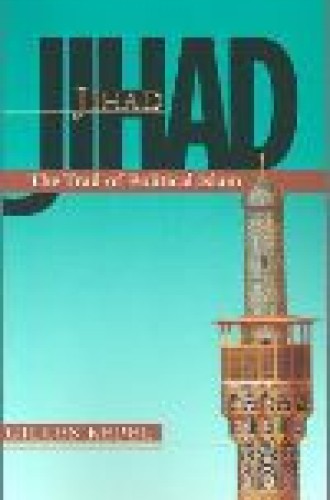Speaking of Islam
How shall we speak about Islam in the aftermath of September 11? Three recent books by scholars with long track records in interpreting the Islamic world present us with three highly distinctive answers. If none gets it quite right, their volumes help us to examine the views dominating public discussion.
Bernard Lewis’s account of Islam might be summarized as follows: “Islam” is the religion of people who are alienated from the religious, moral and political values of Europe and North America. The events of September 11 grew out of the historic tensions between the civilizations we speak of as “Islam” and “the West.” Lewis’s thesis is similar to the view advocated by numerous conservative commentators, talk-show hosts and evangelical Christians. However, his book displays historical knowledge these more popular presenters lack. Sometimes described as the leading historian of Islam working in Europe or North America, Lewis has during his long career published landmark studies of the history of modern Turkey, served as one of the editors of the much-acclaimed Encyclopedia of Islam and won numerous honors and awards for his scholarship.
In dealing with current affairs, Lewis takes the long view. Elites functioning as the guardians of Muslim culture made significant choices at various points in history, choices they understood to be consistent with the basic symbols of Islam. The Prophet Muhammad and those who followed him saw the world as a heedless place in which human beings ignored their duty to God. From the start, Muslims were at war with this milieu. Called to live as idol breakers, they carved out a political and geographic space in which human beings could live as “submitters” (Muslims), obedient to the will of God. They believed it was their destiny to enlarge this space so as to make the entire world conform to the divine will. For much of the first millennium of Islamic history the progress of Islamic culture and the success of Islamic armies seemed to confirm this destiny.
When their fortunes began to turn, Muslims began to ask, “What went wrong?” In the 1680s, Ottoman Turkish armies suffered a number of setbacks which forced the guardians of Islam to cede territory to various European powers. As Europe’s strength grew over the next centuries, the question Why? became the preoccupation of Muslim elites, who in Lewis’s view answered the question in ways that protected Islam from reform.
Through a series of historical vignettes, Lewis presents the argument that Muslim elites saw the success of the West primarily as a matter of technological prowess. The solution to Islam’s loss of power was to purchase and learn to use the products of this prowess. Other aspects of Western culture—for example, the political institutions associated with democracy—were considered either irrelevant or as something to be grafted onto the basic forms of Islamic civilization. Thus traditional interpretations of Islam were never deeply affected. The most persistent and, for Lewis, the most authentic of these interpretations pointed not toward reform but to the recovery of old forms—return to the ways of the Prophet, recovery of the practices of his early companions, and restoration of the glory of the Caliphate and the Islamic empire.
From Lewis’s perspective, the September 11 attacks were an expression of the anger of people who see history passing them by. Rather than follow the path of reform, radical Muslims are choosing the path of destruction. Lewis’s argument is plain enough. More difficult to understand is how he thinks Islam might reform itself. He presents those who call for reform—for example, those who argue that Islam mandates democratic institutions—as outside authentic Islam. Since Lewis seems to identify authentic Islam entirely with the Islam of the 16th- and 17th-century elites, how is Islam to change?
Whereas Lewis sees Islam as the religion of peoples alienated from the West, John Esposito sees it as a preeminently Western tradition, occupying the same religious and moral space as Christianity and Judaism. Unholy War lends a scholarly voice in support of those who see the events of September 11 as another example of how people can use the texts and symbols of a great religion to justify their penchant for destruction. Properly understood, the great monotheisms all bear witness to the one God who created all human beings with equal dignity, Esposito argues. There is no essential opposition between Islam and the West. Viewed correctly, Islam is a contributor to Western civilization, not its archrival.
Like Lewis, Esposito has been arguing his case for years. His many books and articles are clearly the work of an empathetic scholar, highly sensitive to the difficult social and political realities of many countries in which Muslims are a majority. Even more, Esposito is keenly aware of the growing Muslim presence in Europe and North America. To stress affinities between Islam and other Western traditions is important for the future of Muslims in the West, most of whom share the fears and hopes characteristic of immigrant populations striving for acceptance. Moreover, these affinities are plainly a part of the Islamic approach to salvation history, in which Judaism and Christianity occupy a special place as scriptural religions.
About militant or radical Islam, Esposito’s best-known statement prior to September 11 was The Islamic Threat: Myth or Reality? (Oxford University Press, 1992). His answer was “myth,” or largely so. Responding to those who characterized the “Islamic movement” as a “green wave” that would replace communism as a challenge to democratic, capitalist values, Esposito argued that such ideologically driven interpretations were unfounded and would support counterproductive policies. As an alternative, he counseled patience. In countries where Muslims constitute the majority, religious and political leaders would eventually move in the direction of democracy and respect for human rights. Even hardline anti-American rhetoric, he maintained, is often simply a way of appealing to a diverse and troubled set of domestic constituencies, rather than an indication of real-world foreign policy.
Esposito’s approach was controversial even before September 11. Though his viewpoint was much appreciated by Muslims living in the West, his assessment of the threat posed by radical groups was considered overly optimistic by a number of policy analysts. And after September 11, Esposito and those who agree with him came in for vigorous criticism by those in Lewis’s camp.
Unholy War may be read as Esposito’s answer to these critics. He places Usama bin Laden and others like him on the margins of Islamic tradition. Such people are radicals frustrated by the failure of existing governments to deliver on promises of economic and political development, he argues. Driven to despair by the failure of the international community to protect Muslims in Chechnya and Palestine, they find in Islam a convenient vocabulary for the articulation of grievances and the justification of acts of defiance. Those wishing to deal with the terror advocated by radical groups should thus focus on its “root causes”: poverty and lack of political freedom. To affirm the values Muslims share with Jews, Christians and others is a positive response to the disintegration of world community advocated by radicals.
Esposito’s approach has much to commend it. If I had to choose between Lewis and Esposito, I would side with the latter. Still, Esposito’s treatment of bin Laden and other radicals fails to answer the question, “Why and how does Islam provide a convenient vocabulary for a radical program?” Granted that “bin Laden and others go beyond classical Islam’s criteria for a just jihad,” we must still ask, “What makes them believe they can do so and still remain—as bin Laden has repeatedly asserted—God’s chosen vanguard for the protection of the true values of Islam and humanity?” Granted that “Islamic scholars and religious leaders across the Muslim world . . . have made strong, authoritative declarations against bin Laden’s initiatives,” what are the details of their reasoning?
To understand the relationship between Islamic tradition and September 11, we need more details than Esposito gives. We need a more fine-grained approach to the ways contemporary Muslims negotiate the world using the tools provided by Islamic tradition. As “that which is handed down” from one generation to another, Islamic tradition provides believers with a rich variety of possibilities for contemporary life. Some Muslims are (as per Lewis) alienated from the West; others are (as per Esposito) aligned with Jews, Christians and others as advocates of universal human rights. Why? Apparently, the answer is complex. The texts and symbols of Islam play a part in either case, as do factors more directly tied to politics, economics or individual personalities. Given this fact, it becomes difficult if not impossible to characterize Islam and Muslims either as essentially alienated from or as essentially “on board” with the values of Western civilization.
Like Lewis and Esposito, Gilles Kepel is well known to students of Islam. Jihad builds on more than 20 years’ research focused on militant groups. Again and again Kepel shows how militants in quite diverse settings pick up historic threads from the Islamic tradition, give them a new twist in relation to contemporary political realities and attempt to engage other Muslims in forging coalitions that can alter the balance of power in specific societies. An important feature of Kepel’s analysis is his focus on the local character of radical interests. To understand movements like Hamas or Islamic Jihad in Palestine/Israel, one must first turn to intra-Palestinian concerns, not to the program of an Islamic “internationale.” There is a kind of international radical movement among Muslims, Kepel writes, but it is a relatively recent phenomenon, tied to the motives and fortunes of the small number of Arabic-speaking Muslims who fought to end Soviet domination in Afghanistan during the 1980s, then found themselves in the early ’90s with no place to ply their hard-won military skills.
As Kepel shows, the international radicals do not fit neatly with any of the local movements. Since they are committed to a struggle without borders, they tend to minimize the particular issues that animate most militant groups. Instead, the radicals speak of global struggle against an international conspiracy dedicated to the elimination of Muslims. One thinks, for example, of bin Laden’s October 7, 2001, statement indicting the “criminal Kofi Annan” as the leading spokesperson for an international campaign to deny Muslim rights, or more recently of the June 7, 2002, statement by Sulayman abu Ghayth depicting the U.S. as the “head of disbelief” throughout the world.
Nevertheless, it is important for international radicals to connect with local movements. And here, according to Kepel, is an important source of radical weakness. Local Islamic movements tend to forge coalitions involving three sets of constituents: members of a devout middle class, impoverished (especially young) people living in urban centers, and intellectuals. Each group has its own reasons for crafting an Islamic alternative to an existing political regime. Each has its own sense of what would constitute a legitimately Islamic political order.
The devout middle class wants a government devoted to keeping the minds of the young focused on stories of Muhammad and the early Muslims rather than on the latest import from Hollywood. Impoverished urban youths, by contrast, want a more equal distribution of social goods. They want the jobs that will give them a chance to marry and have families. Finally, intellectuals want freedom of expression, a commodity sorely lacking in most Muslim-majority societies.
What happens when international radicals come into this mix? According to Kepel, wherever the commitment of the radicals to indiscriminate violence comes to the fore, the devout middle class withdraws its support. Algeria presents a good example. The slaughter of seven Trappist monks in May 1996 was one of the most visible examples of the terrifying violence to which members of the Islamic movement turned in their campaign against the military regime that came to power in 1992. Because that regime had seized power by nullifying democratic elections in which Islamic parties won a clear victory, many Algerians originally sympathized with the radicals. But radical leaders turned increasingly to indiscriminate violence. Indeed, leaders of the Groupe Islamique Armé eventually declared war on the entire society, blaming the continuing power of the military regime on the general population’s lack of commitment. According to Kepel, the radicals’ failure to discriminate between civilian and military targets brought about a massive defection of the devout middle class from the campaign. And in fact, the GIA ceased to be an organized presence in 1997. An associated group, the Armée Islamique du Salut, eventually declared a unilateral truce.
This pattern is characteristic of events in the Middle East and South and Central Asia. Radical Islam is best understood as a set of movements created by loose coalitions of people working with a variety of religious and political interests. Whenever the interests of a part of these coalitions are threatened, the movements tend to weaken and even disintegrate, with some participants finding their way back to more established modes of political activity. Voting and running for office become more attractive—if those opportunities exist. Thus, the presence of democratic alternatives to militancy is a critical factor.
Though there is much to admire in Kepel’s account, he probably paints too optimistic a picture. When militant coalitions weaken, he tells us, some participants turn to mainstream forms of politics. But where do people go when, alienated by the extreme violence of some radical groups, they find no such opportunities? What happens when those truly committed to violence find their support decreasing? Do they just fade into the background, as Kepel’s analysis of Algeria suggests, or do they strike harder, filled with a sense of overwhelming righteousness? Even diminished radicals can be dangerous.
Kepel does not spend enough time detailing the specifics of Muslim debates about the radicals’ appropriation of Islamic texts and symbols. In the particular case of Usama bin Laden and his colleagues, published statements appear to demonstrate a good-faith effort to connect contemporary political life with the longstanding tradition of Shari‘a reasoning (Islamic “jurisprudence”). Kepel does not do enough to show readers how such reasoning works. Further, Jihad presents little analysis of the debate among Muslims over the validity of bin Laden’s practice of Shari‘a reasoning. Understanding this debate is critical for understanding Islam as a living tradition, and it is necessary for answering the questions about Islam that have dominated public debate since September 11.
Nevertheless, Kepel’s book comes closest to the goal I would set for any analysis of Islam: to depict Islam as a living tradition engaging and in turn engaged by successive generations of believers. Motivated by the Qur’an and the example of the Prophet as depictions of that which is good, beautiful and true in human experience, such believers seek to increase the range of order and meaning in the world. And like all believers, they are capable of the complete range of behaviors characteristic of human beings: love and hate, joy and sorrow, justice and injustice, creativity and destruction. How shall we speak of Islam after September 11? As a religion practiced by human beings. No more, and no less.








